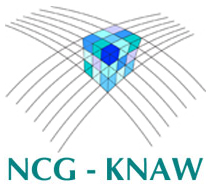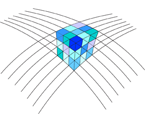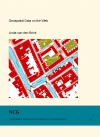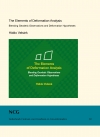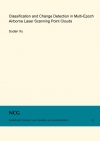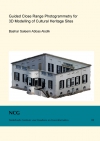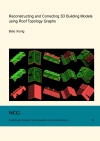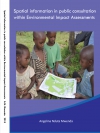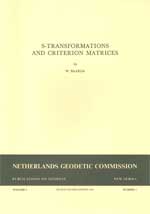
W. Baarda
Publications on Geodesy 18 (Vol. 5 Nr. 1), Second revised edition.
Delft, 1981, 168 pagina's. ISBN-13: 978 90 6132 218 4. ISBN-10: 90 6132 218 9.
Summary
In the publication "A Testing Procedure for Use in Geodetic Networks" [9] a sketch was given for a possible programme of subjects to be studied in Special Study Group No. 1.14 * of the International Geodetic Association. This was an extension of first ideas expressed in 1962 [4a], with a supplement in [4]. Three main problems were formulated:
(1.1) the construction of an artifical covariance matrix, to serve as a mathematical translation of the lower limit of precision required by the purposes of geodetic networks;
(1.2) the use of statistical tests in connection with the adjustment of networks in order to assure the reliability of geodetic networks in relation to their purpose in society; (1.3) the consequences for geodetic networks of a relativation of the concepts north and time.
In [9] {see also [10] for basic theory}, a first solution for (1.2) was given, which since then has been applied to the computation of many densification networks in The Netherlands. The results were very satisfactory, but the method has so far not led to reactions from the members of S.S.G. No. 1.14, and has received little attention from geodesists outside The Netherlands.
The present paper presents a solution for (1.1), a consistent theory which replaces the first draft discussed in November 1964 at Stockholm with the then President of S.S.G. No. 1.14, Professor L. Asplund. The theory has been developed since 1962 by the author and J. E. Alberda, along seemingly very different lines. Many discussions have first led to an improvement of individual ideas, and then, when in 1969 the present paper was drafted, to the insight that the two theories must be identical in essence. A separate publication by Alberda is to be expected; perhaps the differences in argumentation will lead to a clarification of the rather difficult line of thought.
In both investigations, use is made of the theory of the so-called S-transformations, {Dutch: Schrankingstransformaties; English: transformations related to Similarity transformations}, formulated by Baarda around 1944, and applied in the HTW-1956, published in [7], [3] and [5] in the form of 'Similarity covariance transformations'. The present theory was, however, only made possible by a more consistent approach of the S-transformations based on the theory of difference equations for the linearization of functional relationships in adjustment theory. This theory was developed in [1]; a first treatment can be found in [4] section 3.4.
Both researchers also used the criteria for the form and the size of standard ellipses of coordinates of points in a network, which were more or less sketchily formulated by Baarda in the HTW-1956. Alberda chose the way of a further consistent elaboration of this formulation, whereas Baarda in the first instance rejected the approach of the HTW-1956, because it was in conflict with studies on model theory, such as given in [4], section 4, and in the 'Polygon Theory in the Complex Plane' [2].
*) S.S.G. No. 1.14: Specifications for Fundamental Networks in Geometric Geodesy.
[l] W. Baarda - Vereffeningstheorie {Adjustment Theory} - Stencilled edition, Computing Centre of The Delft Geodetic Institute, Delft, 1967, 1970.
[2] W. Baarda - Puntsbepalingssystemen in het platte vlak. Berekening met complexe getallen. {Polygon Theory in the Complex Plane) - Stencilled edition, Computing Centre of the Delft Geodetic Institute, Delft, 1966, 1967, and further provisional text 1968/969.
[3] W. Baarda - Schrankingstransformaties - {S-transformations} - Stencilled edition. Computing Centre of the Delft Geodetic Institute, Delft, 1966.
[4] W. Baarda - Statistical Concepts in Geodesy - Netherlands Geodetic Commission, Publications on Geodesy, New Series, Vol. 2, No. 4' Delft, 1967.
[4a] W. Baarda - A Generalization of the concept Strength of Figure - Report S.S.G 1.14, Delft, 1962 {See Appendix to [4]].
[5] W. Baarda - Statistics: A Compass for the Land Surveyor - Archives 12th International Congress of Surveyors, Vol. B, paper 507 C, London, 1968.
[9] W. Baarda - A Testing Procedure for Use in Geodetic Networks - Netherlands Geodetic Commission, Publications on Geodesy, New Series, Vol. 2, No. 5, Delft, 1968.
[10] W. Baarda - Enkele inleidende beschouwingen tot de "B-methode" van toetsen. {Some introductory considerations on the "B-method" of testing) - Stencilled edition, Computing Centre of the Delft Geodetic Institute, Delft, 1968.
Contents
- 1. An outline of the ideas and their origin 5
- The model of the similarity transformations 20
- A non-singular S-transformation 30
- The connection with earlier ideas 36
- Adjustment to given coordinates 40
- The application of non-singular S-transformations to the adjustment model 44
- Adjustment to given coordinates without correcting them 46
- The comparison of a covariance matrix {of coordinates} with a criterion matrix 48
- The comparison of a covariance matrix with a criterion matrix in an adjustment to given coordinates 53
- The necessity of S-systems for testing on precision 57
- The problem of levelling networks treated as an introduction to the construction of criterion matrices 60
- Criterion matrices for levelling networks 63
- lntroduction of Δd2-terms in criterion matrices for levelling networks 66
- The law of propagation of variances for complex coordinate variates. Circular standard ellipses 76
- Criterion matrices in networks for horizontal control 81
15a. Criterion matrices in systems for horizontal control. Δd2-terms. An alternative derivation 100
16. Axiomatic approach to the model of S-systems 111
17. Connection of several stochastically independent coordinate systems by means of S-transformations 124
18. Application of the theory 136
References 168
Acknowledgements 168
